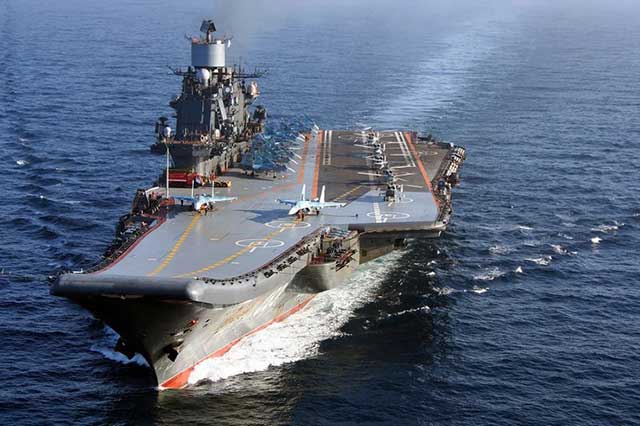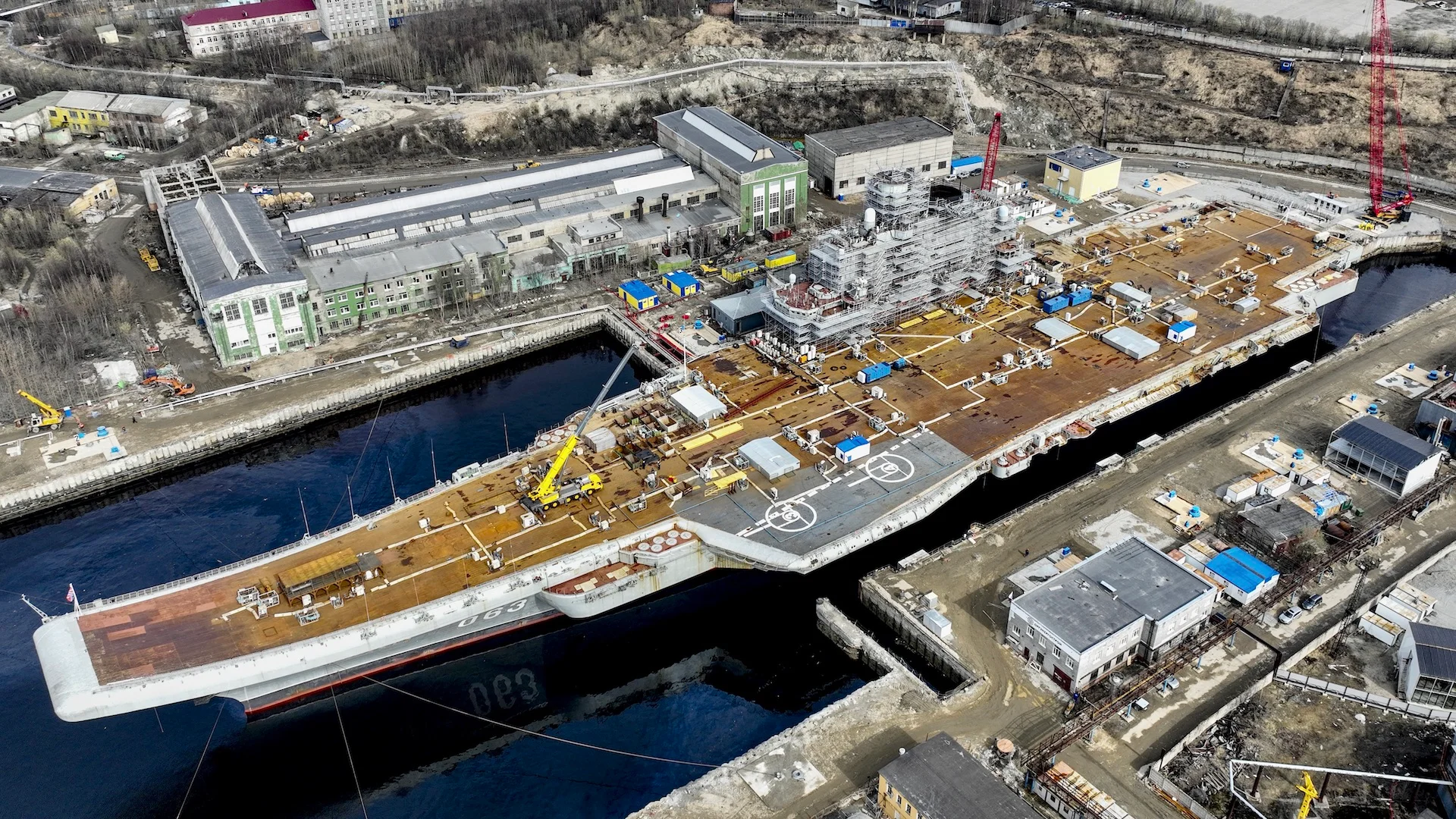Russia Scraps Only Aircraft Carrier: Admiral Kuznetsov’s Retirement Exposes Moscow’s Naval Decline
Moscow’s Last Flattop Faces The Scrapheap As America’s Carrier Fleet Grows Stronger
In a powerful reminder of Russia’s dwindling maritime power projection capability, Moscow now appears ready to retire its only aircraft carrier, the ageing Admiral Kuznetsov, effectively leaving the Kremlin with zero operational flattops while the United States Navy continues to command the seas with a formidable fleet of 11 active aircraft carriers.
A revealing report from the pro-Kremlin daily Izvestia has thrown fresh light on Russia’s intention to scrap the troubled Admiral Kuznetsov — the last lingering symbol of Moscow’s Soviet-era naval aviation dreams — after nearly eight years of chaotic overhaul efforts plagued by catastrophic setbacks, fatal accidents, and spiralling costs.
Citing what it calls “informed sources,” Izvestia claims that the Russian Navy, together with the state-run United Shipbuilding Corporation (USC), are now poised to make the final call to abandon the doomed modernization plan, a move that would strip Russia of any sea-based airpower at precisely the moment its naval assets face unprecedented threats in the Black Sea, the Arctic, and beyond.
The likely decommissioning of the Kuznetsov has strong backing from senior figures within the Russian Navy who increasingly regard traditional aircraft carriers as costly, lumbering targets in the age of stand-off missile systems, hypersonic glide vehicles, and swarm drones.
Admiral Sergei Avakyants, the former commander of Russia’s Pacific Fleet and an influential voice in Moscow’s naval circles, told Izvestia that the Russian Navy “does not need aircraft carriers in their classic form in the long term.”
Avakyants dismissed carriers as relics of an earlier age of maritime warfare, arguing that they “can be destroyed in a few minutes by modern weapons,” underlining how vulnerable massive floating airbases have become in the era of precision strike capabilities and next-generation kill chains.
“It is a very expensive and ineffective naval weapon,” Avakyants declared bluntly.
“The future belongs to carriers of robotic systems and unmanned aircraft.

And if a decision is made not to continue the repairs, the only thing left to do is to take the Admiral Kuznetsov, cut it up for scrap metal, and dispose of it.”
Originally laid down in 1982 and completed in 1991 as the Cold War gasped its last, the Admiral Kuznetsov has come to symbolise both Russia’s once-lofty naval aspirations and the grim reality of post-Soviet shipbuilding decline.
When the Kuznetsov entered dry dock in 2017 for what was meant to be a sweeping overhaul and modernization package, the goal was to extend its service life well into the next decade, giving the Russian Navy at least one operational flattop to match the power projection capabilities of rival blue-water navies.
According to Russia’s state news agency TASS, the ship was initially expected to conduct long-delayed sea trials in spring 2024, with full re-entry into active service pencilled in for late 2025 — a timeline now looking increasingly irrelevant.
Years of crippling technical failures, catastrophic fires, and mounting casualties have turned the Admiral Kuznetsov into what many Russian observers now derisively call the Navy’s “cursed warship.”
Since its commissioning, the 58,000-ton vessel — officially classified as an aircraft-carrying cruiser to skirt the Montreux Convention’s restrictions on passage through the Turkish Straits — has spent far more time tied up at its home port than underway, thanks to Russia’s chronic underfunding of its naval operations.
Defence watchers often joke that if the Kuznetsov even manages to leave its moorings and make it past the breakwater, that alone counts as a tactical success.


The ship’s list of misfortunes reads like a cautionary tale for any navy that neglects maintenance and industrial competence.
In 2009, a fire during operations off Turkey killed a crew member, followed barely a month later by an oil spill that dumped some 300 tonnes of fuel off Ireland during a risky replenishment at sea.
By 2012, the Kuznetsov had broken down in the stormy Bay of Biscay and had to be ignominiously towed home by the loyal Russian tug Chiker, which has shadowed the ship for decades as insurance against its notorious propulsion failures.
The ship’s Syria deployment in 2016-17 — its first combat action — was meant to showcase Russian naval air power but ended up highlighting its crippling shortcomings instead.
Two carrier-based fighters, a MiG-29K and a Su-33, crashed while attempting to land, forcing the carrier to abort operations off the Syrian coast and limp back to the Russian naval base at Tartus.
The calamities did not stop there.
In 2018, a 70-tonne crane used in the ship’s dry dock overhaul collapsed onto its deck, killing one worker, injuring four more, and punching a gaping 16-foot hole in the hull — a devastating setback that further delayed the modernization program.
In December 2019, yet another fire erupted in the engine room during welding work, killing two people and sending 14 others to hospital with severe smoke inhalation.
In 2022, the carrier suffered yet another blaze, cementing its status as one of the world’s most accident-prone warships — a reputation that stands in stark contrast to the United States Navy’s global carrier strike group operations.
While Russia prepares to retire its sole flattop, the U.S. Navy shows no sign of shrinking its dominance at sea.
The American fleet’s 11 nuclear-powered carriers, including the next-generation Ford-class supercarriers, remain the linchpin of U.S. power projection from the Pacific Rim to the Gulf of Oman.
With stealth fighters like the F-35C, deck-launched drones, and cutting-edge electronic warfare squadrons, the U.S. carrier force is evolving for 21st-century conflict scenarios that increasingly test Chinese naval expansion and Russian regional gambits.
China, meanwhile, is rapidly ramping up its carrier program with the Shandong already operational and the new Fujian poised to push the People’s Liberation Army Navy (PLAN) closer to true blue-water carrier operations that might one day rival America’s maritime reach.
In the Indo-Pacific, the rebalancing of sea power has never been more visible.
India continues to expand its carrier ambitions with the INS Vikrant, Britain’s Royal Navy deploys the Queen Elizabeth-class carriers to bolster NATO’s strategic footprint, and France’s Charles de Gaulle remains a crucial asset for European rapid-response missions.
Yet Russia, a country that once dreamed of matching the U.S. carrier fleet ship-for-ship during the Cold War, now faces a future where its last carrier is destined for the scrapyard.
Without the Kuznetsov, Moscow’s blue-water ambitions appear hollow.
Russia will likely be forced to lean even more heavily on land-based aviation, long-range missiles, and a growing arsenal of unmanned and hypersonic systems to plug a gaping hole in its naval doctrine.
But for all the Kremlin’s boasts about drone motherships and next-generation autonomous weapons, the reality is that Russia’s shipbuilding industry, battered by years of sanctions, mismanagement, and technological gaps, remains incapable of delivering a credible replacement for the Kuznetsov anytime soon.
As the United States Navy’s carrier strike groups continue to project American sea power across the world’s contested hotspots — from the Taiwan Strait to the Mediterranean — Russia’s final flattop inches ever closer to the scrapyard, a powerful symbol of an era now slipping away.


